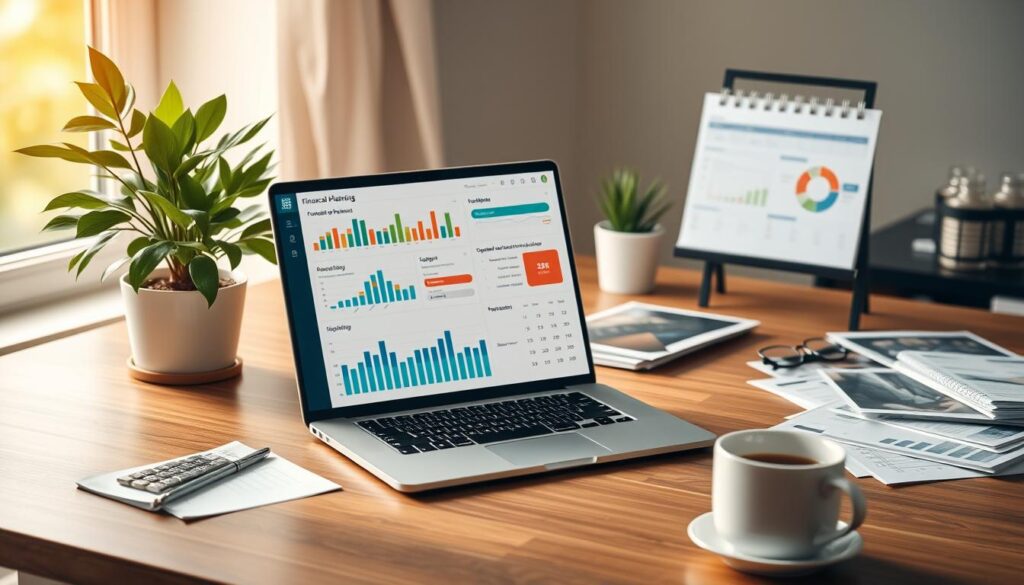What are target-date funds and are they good for young investors ?
If you’re young and looking to invest for the future, target-date funds might be a good choice. They adjust their investment mix as you get older. This makes them easy for young people to use for big life events like retirement.
Target-date funds are great because they let you invest in many things with just one fund. This is perfect for beginners who don’t want to pick individual stocks or bonds. They offer a mix of stocks, bonds, and more, with automatic adjustments to keep your investment balanced.

When picking where to invest, it’s key to weigh the pros and cons. Target-date funds are good for those who plan to invest for a long time. They help you grow your money over years, even when the market goes up and down.
Important Points
- Target-date funds are a type of investment fund that automatically adjusts its asset allocation over time.
- These funds are designed for young investors who want to invest for retirement or other long-term goals.
- Target-date funds offer a diversified portfolio with a single fund, making them a convenient choice for new investors.
- Automatic rebalancing and portfolio management are key benefits of target-date funds.
- Target-date funds can be an attractive option for young investors who want to invest for the long term and are willing to ride out market fluctuations.
- These funds can help you take advantage of the power of compounding and potentially grow your wealth over time.
Understanding Target-Date Funds: The Basics
When looking into investment options, you might see target-date funds. They offer a simple way to save for retirement or long-term goals. To get how they work, it’s key to know the basics and the glide path concept.
Definition and Core Components
A target-date fund is a mutual fund that changes its mix of investments based on a target date, like your retirement year. It combines stocks, bonds, and other investments. These are chosen based on the fund’s glide path.
How Target-Date Funds Work
These funds adjust their mix of investments over time. They move from riskier to safer investments as the target date nears. This helps lower risk and increase stability as you near retirement.
The Glide Path Explained
The glide path is key in a target-date fund. It shows how the investment mix changes over time. It starts with a mix that’s mostly stocks and gradually shifts to more bonds.
Knowing the basics of target-date funds helps you make smart investment choices. It lets you pick the right fund for your goals.
| Target Date | Asset Allocation |
|---|---|
| 2050 | 60% Stocks, 40% Bonds |
| 2040 | 50% Stocks, 50% Bonds |
| 2030 | 40% Stocks, 60% Bonds |
The Evolution of Your Investment Over Time
When you think about long-term investing, it’s key to know how your investment will change over time. Target-date funds adjust their mix of assets to become more safe as the target date gets closer. This investment evolution helps you reach your long-term financial goals.
Target-date funds are great because they automatically adjust your portfolio. This is especially good for new investors. By investing in a target-date fund, you use long-term investing strategies without needing to constantly change your portfolio.
- Automatic rebalancing to maintain an optimal asset allocation
- A glide path that becomes more conservative as the target date approaches
- Professional management to help you achieve your long-term financial goals
Understanding how target-date funds work is crucial. It helps you make smart choices for your investment portfolio. This way, you can secure your financial future.
Key Benefits of Target-Date Funds for Young Investors
As a young investor, you’re looking for ways to grow your money safely. Target-date funds are a smart choice. They offer many benefits that help you reach your financial goals. One big plus is they create a diverse portfolio with little effort from you.
Automatic Rebalancing Features
Target-date funds have automatic rebalancing. This means the fund manager keeps your portfolio in check. It’s great for young investors because it saves time and reduces the chance of making emotional decisions.
Professional Management Advantages
These funds are managed by experts. They have the skills to make smart choices for your money. This is a big plus for young investors who might not know how to manage their investments well.
Some key benefits of target-date funds for young investors are:
- Low maintenance: Target-date funds are easy to manage, letting you focus on other things.
- Professional management: Experts handle your investments, helping you make the most of your money.
- Flexibility: There are many options, so you can pick the one that fits your goals and risk level.
What Makes Target-Date Funds Different from Other Investment Options
Investment options are many, but target-date funds are unique. They offer a mix of assets that changes over time. This makes them great for young investors.
Target-date funds have a special plan called a glide path. This glide path shows how the fund’s mix of assets will change. For example, a fund aimed at 2050 starts with a bold mix and gets safer as it gets closer to 2050.
Here are some key differences between target-date funds and other investment options:
- Automatic rebalancing: Target-date funds adjust their mix of assets over time. This keeps your portfolio on track.
- Professional management: Experienced pros manage these funds. They make decisions for you.
- Diversification: Target-date funds spread risk across different types of investments. This helps reduce the impact of market ups and downs.
Target-date funds also offer a range of choices for different risk levels and goals. Whether you’re cautious or bold, there’s a fund for you.
Target-date funds are special because they offer a mix of benefits. They provide a balanced portfolio, automatic adjustments, and expert management. This helps you reach your long-term financial goals with confidence.
| Investment Option | Key Features | Benefits |
|---|---|---|
| Target-Date Funds | Automatic rebalancing, professional management, diversification | Reduced risk, increased potential for long-term growth |
| Other Investment Options | Manual rebalancing, self-management, limited diversification | Higher risk, potential for lower returns |
Understanding Target-Date Fund Fees and Expenses
Investing in target-date funds means looking at their fees and expenses. Fees can reduce your earnings. It’s key to know the management fee and any hidden costs.
Target-date funds usually have a management fee between 0.1% and 1.5% of the fund’s assets. This fee pays for managing the fund, including administrative and marketing costs. There might also be other expenses like trading costs and custody fees.
To understand better, here’s a breakdown of typical fees and expenses for target-date funds:
| Fee Type | Typical Range |
|---|---|
| Management Fee | 0.1% – 1.5% |
| Trading Costs | 0.01% – 0.1% |
| Custody Fees | 0.01% – 0.05% |
When comparing target-date funds, look at the total expenses ratio. This includes all fees and expenses. This way, you can choose a fund that fits your investment goals and risk level.
How to Choose the Right Target-Date Fund
Choosing a target-date fund involves several key factors. Your investment goals, risk tolerance, and time horizon are all important. It’s crucial to compare different funds and make a well-informed choice.
The glide path of a target-date fund is a key feature. It shows how the fund’s investment mix changes over time. Some funds are more conservative, while others are more aggressive. Think about what you need and want when looking at a fund’s glide path.
Here are some tips for choosing the right target-date fund:
- Assess your risk tolerance and investment goals
- Evaluate the fund’s glide path and asset allocation
- Consider the fees and expenses associated with the fund
- Research the fund’s performance and reputation
By following these tips and carefully evaluating your options, you can make an informed decision when selecting a target-date fund. Remember to consider your individual needs and goals, and don’t hesitate to seek professional advice if needed.

The right target-date fund for you will depend on your unique circumstances and goals. By taking the time to research and evaluate your options, you can make a confident decision. This will help you achieve your investment objectives with target-date funds.
| Target-Date Fund | Glide Path | Fees and Expenses |
|---|---|---|
| Fund A | Conservative | 0.5% |
| Fund B | Aggressive | 0.8% |
| Fund C | Moderate | 0.6% |
Common Misconceptions About Target-Date Funds
There are many misconceptions about target-date funds that can affect your investment choices. One big one is thinking they are a “set it and forget it” investment. But, this isn’t entirely right. Target-date funds do make investing easier, but you should still check and adjust your portfolio often. This ensures it stays on track with your goals.
Another common mistake is believing target-date funds are completely safe. But, all investments have some risk, and target-date funds are no different. Risk management is key when investing in these funds. Knowing the risks and benefits helps you make better choices and avoid problems.
The “Set It and Forget It” Myth
This myth can harm your investment portfolio. It might make you overlook important changes. In truth, target-date funds need regular checks to keep them in line with your goals.
Risk Management Realities
Risk management is vital when investing in target-date funds. By knowing the risks and benefits, you can make smarter choices. Here are some important things to consider:
- Assessing your personal risk tolerance
- Understanding the fund’s investment strategy
- Regularly reviewing and adjusting your portfolio
Target-Date Funds in Your 401(k) and IRA
Planning for retirement means looking at different options, like 401(k) and IRA accounts. Target-date funds are a good choice for these accounts. They adjust their investments automatically, making them easy to use for saving for retirement.
Target-date funds offer a simple way to save for retirement. They let professionals manage your investments and rebalance them for you. This can lower risk and increase potential gains. Plus, they’re often found in 401(k) and IRA accounts, making it easy to add them to your retirement plan.
Integration with Retirement Accounts
Target-date funds can be part of your retirement accounts, like 401(k) or IRA. They help create a diverse investment portfolio. This approach can help you reach your retirement goals while managing risk.
Employer-Sponsored Options
Many employers include target-date funds in their 401(k) plans. This is a great way to start saving for retirement. Target-date funds are easy to understand and require little upkeep. If your employer offers them, it’s worth considering for your retirement plan.
Here’s a quick look at the benefits of target-date funds in your 401(k) and IRA:
- Automatic rebalancing and professional management
- Diversified investment portfolio
- Convenient and hands-off approach to investing
- Available in 401(k) and IRA accounts
Adding target-date funds to your retirement plan can help you build a diversified portfolio. They’re useful whether you’re just starting to save or are close to retirement. Target-date funds can be a valuable part of your investment strategy.
| Retirement Account | Target-Date Fund Option | Benefits |
|---|---|---|
| 401(k) | Yes | Automatic rebalancing, professional management |
| IRA | Yes | Diversified investment portfolio, convenient and hands-off approach |
Risk Considerations for Young Investors
As a young investor, knowing the risks of target-date funds is crucial. These funds can help diversify your portfolio but also come with risks. One major risk is losing money if the market drops. Since these funds invest in stocks, bonds, and more, your investment’s value could fall.
To lessen this risk, having a long-term view and a diversified portfolio is key. Risk management is vital when investing in target-date funds. Also, be mindful of the fees these funds charge, as they can reduce your earnings over time. By understanding and managing these risks, you can make smart investment choices and reach your financial goals.
Here are some tips for young investors to consider when it comes to target-date funds and risk:
- Start early and be consistent with your investments
- Diversify your portfolio to minimize risk
- Understand the fees associated with your target-date fund
- Monitor your investments regularly and make adjustments as needed

By following these tips and being aware of the potential risks, you can maximize your investments in target-date funds. Remember, investing always carries some risk. But by being informed and proactive, you can reduce your risk and increase your returns.
Alternative Investment Strategies to Consider
Looking into other investment choices? You might find alternatives to target-date funds interesting. Options like ETFs and robo-advisors offer more control and flexibility.
ETFs, or exchange-traded funds, cover a wide range of investments. This includes stocks, bonds, commodities, and currencies. They can be traded like stocks, helping you quickly adjust to market changes. Robo-advisors, meanwhile, manage your investments automatically. They often cost less than traditional financial advisors.
ETFs vs Target-Date Funds
ETFs and target-date funds differ in key ways. ETFs can be traded all day, giving you quick market access. Target-date funds, however, are traded at the end of the day. Plus, ETFs usually have lower fees.
Robo-Advisors as Alternatives
Robo-advisors are great for those who prefer a hands-off approach. They use algorithms to create diversified portfolios and charge lower fees. Popular choices include Betterment and Wealthfront.
Before choosing alternative investments, think about your financial goals and risk level. It’s also wise to talk to a financial advisor. They can help find the best strategy for you.
| Investment Option | Fees | Flexibility |
|---|---|---|
| Target-Date Funds | 0.5-1.5% | Low |
| ETFs | 0.1-1.0% | High |
| Robo-Advisors | 0.2-0.5% | Medium |
Making Target-Date Funds Part of Your Investment Strategy
When looking at investment options, think about how target-date funds fit into your strategy. They make investing for retirement easy. They adjust their mix of assets based on when you plan to retire.
To add target-date funds to your portfolio, keep these tips in mind:
- First, check your current investments and see where target-date funds can help.
- Think about how much risk you can handle and how long you have to invest. This will help pick the right target-date fund.
- Choose funds with low fees to keep more of your money.
By using these tips and thinking about your investment strategy, you can wisely use target-date funds. Remember to check and adjust your portfolio often. This keeps it in line with your changing needs and goals.
With a smart investment strategy and the right portfolio mix, target-date funds can help you secure a bright financial future.
| Investment Option | Risk Level | Time Horizon |
|---|---|---|
| Target-Date Funds | Medium | Long-term |
| Stocks | High | Short-term |
| Bonds | Low | Medium-term |
Conclusion: Are Target-Date Funds Right for Your Future?
Target-date funds can be a great tool in your investment journey. They adjust their mix of assets as you get closer to retirement. This makes managing your portfolio easy. But, they might not be the best choice for everyone.
Whether target-date funds are right for you depends on your risk level, time frame, and goals. Knowing the pros and cons helps you decide. With the right advice and a balanced portfolio, target-date funds can help you secure your financial future.
FAQ
What are target-date funds and are they good for young investors?
Target-date funds adjust their investment mix based on when you plan to retire. They’re great for young people because they start off with a mix of investments. As you get closer to retirement, they become more conservative, helping secure your future.
What are the key benefits of target-date funds for young investors?
Target-date funds offer automatic rebalancing and professional management. They save you time and help you reach your financial goals. You don’t have to manage your investments yourself.
How do target-date funds work and what is the glide path?
Target-date funds adjust their investment mix over time, becoming more conservative as you near retirement. This is called the “glide path.” It helps reduce risk and ensures your investments are aligned with your long-term goals.
What fees and expenses are associated with target-date funds?
Target-date funds have management fees and other costs. It’s crucial to understand these fees as they can affect your investment’s performance. Compare fees from different providers to find the best value.
How can I choose the right target-date fund for my needs?
Look at the fund’s asset allocation, glide path, fees, and performance history. Make sure the target date matches your retirement plans. This helps you pick a fund that fits your investment goals and risk level.
What are some common misconceptions about target-date funds?
Some think target-date funds are a “set it and forget it” option. But, while they offer automatic rebalancing, it’s still important to monitor your investments. They don’t eliminate all investment risk, so understanding the risks is key.
How can I integrate target-date funds into my 401(k) or IRA?
Target-date funds are easy to add to your 401(k) or IRA. Many employers offer them as a retirement option. You can also invest in them through your IRA, making it simple to include them in your retirement plan.
What are some alternative investment strategies to consider beyond target-date funds?
Besides target-date funds, consider ETFs and robo-advisors. ETFs offer diversification and rebalancing, while robo-advisors provide a hands-off investing experience. Evaluate each option to find the best fit for your investment strategy.
